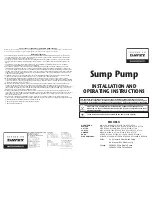
Page 14
505328M 06/09
2. Remove any shipping clamps holding the liquid line
and distributor assembly.
3. Using two wrenches, disconnect liquid line from
distributor. Take care not to twist or damage distributor
tubes during this process.
4. Remove and discard RFC bullet and Teflon washer.
5. Remove and discard cap from the equalizer line port
on the vapor line. Check for valve core in port fitting
and if installed, remove from port.
6. Install one of the provided Teflon washers around the
stubbed end of the CTXV.
7. Attach the stubbed end of the kit valve to the distributor
assembly.
8. Place the remaining Teflon washer around the other
end of the CTXV.
9. Attach the liquid line to the CTXV.
10. Attach the sensing bulb of the CTXV in the proper
orientation to the vapor line using the clamp an screws
provided with the CTXV.
11. Connect the equalizer line from the CTXV to the
equalizer vapor port on the vapor line.
12. To prevent against any possibility of water damage,
properly insulate all parts of the CTXV assemble that
may sweat due to temperature differences between
the valve and its surrounding ambient temperatures.
13. The expansion/check valve can be installed internally
in coil blowers, or external or internal to indoor coil only
applications.
Expansion valves equipped with Chatleff type fittings are
available from Lennox. Refer to the Engineering
Handbook for CTXV kits for use with specific match−ups.
Table 4. Indoor CTXV Kits
Model
Kit Number
XP15−024 and −036
49L24
XP15−048 and −060
91M02
IMPORTANT
Failure to remove a fixed orifice when installing an
expansion valve to the indoor coil will result in
improper operation and damage to the system.
If the indoor unit being installed came with a fixed orifice
type metering device, remove that orifice and install the
CTXV as illustrated in figure 23.
Installing Service Valve Port Core
Re−install both of the outdoor unit’s service port cores
(liquid and vapor) as illustrated in figure 24.
DO NOT INSTALL
CAPS AT THIS TIME
INSTALL SERVICE
PORT CORES
OUTDOOR UNIT
LIQUID AND VAPOR
SERVICE VALVES
Figure 24. Typical Service Valve Port Core
Installation
Evacuating the System
WARNING
Danger of Equipment Damage. Avoid deep
vacuum operation. Do not use compressors to
evacuate a system. Extremely low vacuums can
cause internal arcing and compressor failure.
Damage caused by deep vacuum operation will
void warranty.
IMPORTANT
Use a thermocouple or thermistor electronic vacuum
gauge that is calibrated in microns. Use an instrument
capable of accurately measuring down to 50 microns.
Evacuating the system of non−condensables is critical for
proper operation of the unit. Non−condensables are
defined as any gas that will not condense under
temperatures and pressures present during operation of
an air conditioning system. Non−condensables and water
vapor combine with refrigerant to produce substances that
corrode copper piping and compressor parts.
1. Connect manifold gauge set to the service valve ports
as follows:
S
low pressure gauge to
vapor
line service valve
S
high pressure gauge to
liquid
line service valve
2. Connect micron gauge.
3. Connect the vacuum pump (with vacuum gauge) to
the center port of the manifold gauge set.
4. Open both manifold valves and start the vacuum
pump.
5. Evacuate the line set and indoor unit to an
absolute
pressure
of 23,000 microns (29.01 inches of
mercury).
NOTE −
During the early stages of evacuation, it is
desirable to close the manifold gauge valve at least once to
determine if there is a rapid rise in sure indicates a
relatively large leak. If this occurs,
repeat the leak testing
procedure
.
NOTE − The term
absolute pressure
means the total
actual pressure within a given volume or system, above
the absolute zero of pressure. Absolute pressure in a
vacuum is equal to atmospheric pressure minus vacuum
pressure.
6. When the absolute pressure reaches 23,000 microns
(29.01 inches of mercury), close the manifold gauge
valves, turn off the vacuum pump and disconnect the














































